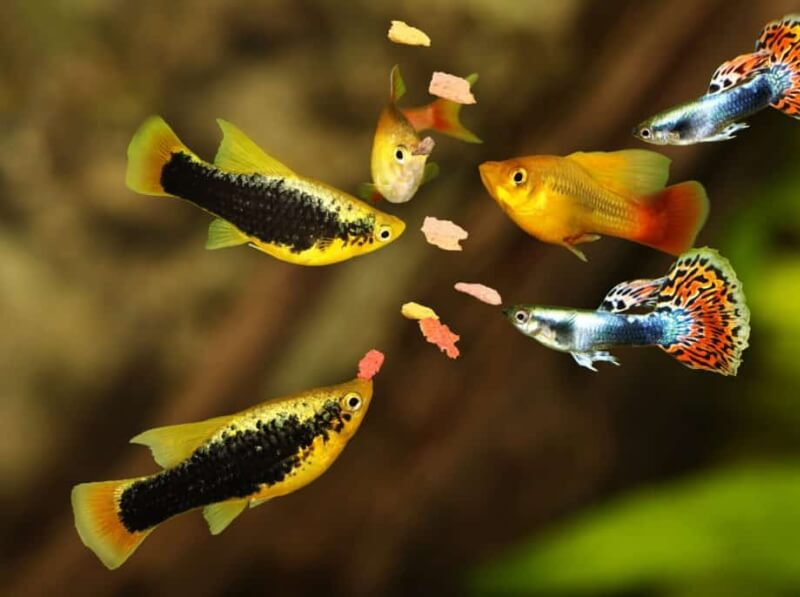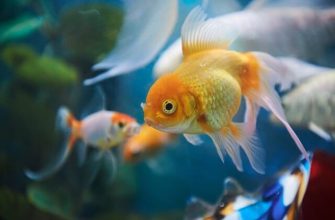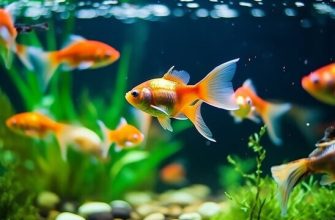Goldfish have been cherished pets for centuries, captivating people with their vibrant colors and graceful movements. If you’re a goldfish enthusiast or considering bringing one into your home, you might be wondering, “How long do goldfish live?” This question doesn’t have a one-size-fits-all answer, as various factors influence their lifespan.
Let’s explore the intricacies of goldfish longevity and how to ensure your finned friends live their best lives.
Typical Lifespan
The typical lifespan of a pet goldfish kept in captivity is about 10-15 years on average, with proper care and ideal conditions. However, goldfish are capable of living significantly longer when provided optimal tank conditions, nutrition, and disease prevention. In fact, the longest living goldfish on record reached an astonishing 45 years of age!
In the wild, goldfish live much shorter lives of only 5-10 years on average. Their lifespan in nature is impacted by predation, parasites, disease, and food availability. Providing a safe, clean aquarium environment with a balanced diet allows pet goldfish to far exceed their average natural lifespan. With dedicated care, goldfish can potentially live up to 3-4 times longer in captivity compared to the wild.
Ideal Tank Conditions

Goldfish thrive in large aquariums or outdoor ponds with plenty of swimming space. The general rule is to provide at least 20 gallons for the first goldfish, plus an additional 10 gallons per additional goldfish. Goldfish can grow quite large, with commons reaching 12 inches, so they require much more room than typical small aquarium fish. The minimum recommended size is a 55-60 gallon tank for 1-2 fancy goldfish. For common goldfish, a 100+ gallon tank or pond is ideal.
Goldfish prefer cool water between 65-72°F. Temperatures above 75°F can cause stress. A submersible aquarium heater can help maintain a stable temperature if needed.
The ideal pH range for goldfish is 7.0-8.0. Regular water changes and testing helps maintain pH. A pH between 6.5-7.2 provides enough acidity to prevent diseases.
Goldfish are messy fish that produce a lot of waste. Powerful filtration like a canister filter helps keep water clean. Aim for filtration that turns over the tank volume at least 4-5 times per hour. Additional filtration like an air stone improves oxygenation. Partial water changes of 25-50% weekly helps remove nitrates.
Diet
A nutritious and varied diet is important for goldfish health and longevity. The recommended foods for goldfish are vegetables, including boiled peas, zucchini, spinach, and lettuce, as well as high-quality sinking pellets that are specially formulated for goldfish nutritional needs. Flake foods should be avoided as they can cause swim bladder problems.
Goldfish should be fed small amounts 1-2 times per day, only enough food that they can completely finish within a few minutes. Overfeeding can lead to poor water quality and health issues. They have voracious appetites and will act hungry even when fed sufficiently.
Nutritionally, goldfish require a diet high in vegetable matter and fiber to promote digestion and prevent constipation. Protein should make up 25-35% of the diet from sources like shrimp, bloodworms, daphnia. Spirulina and carotenoids are also important for enhancing coloration. A variety of foods will ensure all nutritional requirements are met.
Health Issues
Goldfish are susceptible to several diseases and illnesses. The most common goldfish diseases include ichthyophthirius, or “ich,” a parasitic infection that causes white spots. Fin rot, a bacterial infection that causes fraying fins, is also prevalent. Other common ailments are buoyancy disorders that cause floating and swimming problems and intestinal issues like constipation and bloating.
Many goldfish illnesses can be prevented through proper tank maintenance. Performing regular water changes, cleaning the tank and filter, and testing water parameters helps reduce risk. Watching for early signs of disease like loss of appetite, lethargy, faded colors, frayed fins, and spots/growths can allow for prompt treatment. Quarantining new fish and plants prevents introducing pathogens.
If disease occurs, treat based on symptoms. Anti-parasitic and anti-bacterial medications treat common pathogens. Improving water quality, feeding peas for constipation, and epsom salt baths can also help treat sick fish. Working quickly when signs appear gives goldfish the best chance of recovery.
Tank Mates

Goldfish are social fish that typically do well with tank mates. However, their tank mates need to be chosen carefully to avoid issues with aggression or overstocking the tank.
Some compatible options include:
-
Other peaceful community fish like white cloud mountain minnows and zebra danios can make good tank mates as they prefer similar water conditions. Introduce any new fish gradually and monitor for aggression.
-
Bottom dwelling fish like corydoras catfish and bristlenose plecos can help clean up uneaten food and algae. Make sure to provide plenty of hiding spots.
-
Invertebrates like nerite snails and ghost shrimp can help clean algae and debris. However, goldfish may eat shrimp.
It’s important not to overstock the tank. Generally only 1 fancy goldfish per 20 gallons is recommended. Monitor water parameters closely with tank mates. Perform regular partial water changes and filtration maintenance to keep water clean.
Routine Care
Proper routine care is crucial for goldfish longevity. The water quality must be pristine to avoid disease and stress.
Here are some key routine care tasks:
-
Water Changes: Perform partial water changes of 25-50% weekly. Use a gravel vacuum to remove debris during water changes. The new water should be dechlorinated and temperature matched to the tank water. Frequent water changes are vital for reducing nitrates and replenishing minerals.
-
Tank Cleaning: Clean the tank walls to remove algae buildup. Wipe decorations and gravel to get rid of waste. Avoid complete gravel cleaning as this removes beneficial bacteria.
-
Water Testing: Test water parameters like ammonia, nitrite, nitrate and pH weekly. Use liquid test kits not strips for accuracy. Ideal levels are 0 ppm ammonia/nitrites, <20 ppm nitrates, pH 7-8. Promptly correct any parameter deviations.
Regular maintenance and monitoring allows early intervention against disease outbreaks. This helps extend goldfish lifespan in home aquariums.
Breed
Goldfish come in many different breeds with varying body types, fin configurations, colorations and more. Some popular breeds include Comets, Shubunkins, Fantails, Ranchus, and Pearlscales.
Breeds can differ significantly in body shape, with some having long, slender bodies like Comets, and others having short, rounded bodies like Fantails. Fin types also vary, with breeds like Fantails having large, flowing fins, while others like Shubunkins have smaller, delicate fins. Coloration ranges from solid orange, to calico patterns, to all white.
Lifespans also differ somewhat between breeds. Smaller, slender-bodied breeds like Comets generally live longer, around 10 years. Larger, fancy breeds with rounder bodies and elaborate fins like Orandas tend to have shorter lifespans of 5-8 years. Proper care and ideal tank conditions can help extend the lifespan of all varieties.
Age
Determining the age of a goldfish can be tricky, but there are some signs to look for. Young goldfish usually have short fins and muted colors. As they mature, their fins grow longer and their colors become more vibrant. One rule of thumb is that a 1 inch goldfish is typically 4-6 weeks old.
Signs that a goldfish is aging include faded colors, frayed fins, cloudy eyes, sluggish movement, and an arched back. Goldfish growth tends to slow down after the first few years. Most goldfish live for 5-10 years, but some can survive over 20 years with proper care. The oldest recorded goldfish lived to the ripe old age of 43! While it’s difficult to determine the exact age, you can make reasonable guesses based on the goldfish’s size, color, activity level, and overall health.
Extending Lifespan

There are several things you can do to help extend the lifespan of your goldfish:
-
Provide a large tank with plenty of swimming space. Goldfish thrive in ponds or tanks of at least 20-30 gallons per fish. Overcrowding causes stress and disease.
-
Maintain excellent water quality with proper filtration and frequent partial water changes. Test and adjust water parameters regularly. Goldfish are sensitive to poor water conditions.
-
Feed a varied, high-quality diet with minimal fillers. Avoid overfeeding. Uneaten food fouls the water.
-
Keep the tank clean. Remove uneaten food, dead plant matter, and waste promptly. Clean decorations and gravel regularly.
-
Quarantine and treat sick fish promptly. Move bullied or stressed fish to separate tanks. Prompt treatment can prevent contagious diseases.
-
Keep water temperature cool, between 65-72°F. Rapid temperature fluctuations stress fish.
-
Provide proper lighting on a consistent schedule. Light encourages natural behaviors and minimizes stress.
-
Avoid common mistakes like small bowls, overcrowding, poor water conditions, or inadequate nutrition. These factors dramatically shorten lifespan. With proper care, goldfish can live 10 years or longer.
Providing an appropriate environment and high-quality care are key to maximizing goldfish longevity.
Record Ages
The oldest documented goldfish on record lived to the remarkable age of 43 years old. His name was Tish, and he was won at a funfair in 1956 by a couple in Yorkshire, England. Tish survived until 1999, far exceeding the normal lifespan for goldfish. Over the decades, his scales even turned from gold to silver due to his advanced age.
There have been claims of goldfish living even longer, up to 45 years, but these are unverified. Record-keeping would have to be meticulous to confirm such extraordinary life spans. Some goldfish owners may pass down fish through generations of a family and unintentionally exaggerate their ages over time. Without photographic evidence or veterinary documentation, longevity claims over 30 years should be taken with skepticism.
The current Guinness World Record holder for the oldest goldfish is Goldie, who reportedly lived for 45 years until 2005. While Goldie’s owners provided photos and records, his age was not independently verified throughout his life. Tish remains the longest-lived goldfish according to reliable evidence. Exceeding 40 years is extremely rare, even with ideal care.








